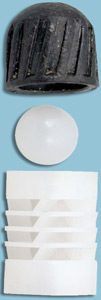Home | Glossary | Resources | Help | Contact Us | Course Map
Archival Notice
This is an archive page that is no longer being updated. It may contain outdated information and links may no longer function as originally intended.
Shotshell Projectiles
Examination of projectile related materials includes
- shot pellets Determination of size, composition, and other physical characteristics,
- buckshot Determination of size,
- shotgun slugs Determination of manufacturer or marketer, gauge, and individual characteristics (in some cases).
Buffer Materials
Buffer materials are a form of trace evidence most often detected in the microscopic examination of the clothing from a shotgun shooting victim. The physical appearance of buffer materials should be documented.
Buffer material is particulate in nature and usually composed of polyethylene or polypropylene. Many older buffer materials were pigmented (black, blue, light yellow), but currently are generally white in color. Shot pellets and the hollow bases of slugs fired from a shotshell containing buffer materials show microscopic impressions of the buffer material on their surface.
It may be possible through instrumental analysis of buffer particulate to determine the manufacturer/marketer.
Inconsistencies
In the examination of fired shotshell components, it is advisable to determine whether or not all of the evidence items are consistent with a particular loading, manufacturer, and gauge. Any component that does not appear consistent with other recovered components may indicate a second type of ammunition or the involvement of a second firearm.
Since components are subjected to strong and violent forces during firing, their condition does not always yield the best data.
Examination
When fired shotshell components are examined, laboratory policies must be followed, including
- chain of custody,
- laboratory safety,
- trace evidence,
- Coordination of examination sequencing across disciplines to preclude loss of trace evidence.
Preliminary Procedure
The preliminary steps for the examination of fired shotshell components are as follows:
- Mark evidence according to laboratory procedures.
Note: Shot pellets, buckshot, and buffering materials by nature are impractical to mark directly. Their packaging should be marked and appropriate notations made in the related worksheet. - Photograph and document original condition of evidence.
- Determine equipment necessary for examination.
- Laboratory-approved worksheet.
- Reference standards.
- Stereo microscope.
- Evidence marking items.
- Small hand tools, as required.
- Equipment for measuring dimensions of components, such as
- calipers,
- stereo microscope with micrometer and calipers,
- stereo microscope with optical grid,
- stereo microscope and machinists steel rule,
- measuring projector,
- comparison microscope with micrometer (air gap method).
Additional Online Courses
- What Every First Responding Officer Should Know About DNA Evidence
- Collecting DNA Evidence at Property Crime Scenes
- DNA – A Prosecutor’s Practice Notebook
- Crime Scene and DNA Basics
- Laboratory Safety Programs
- DNA Amplification
- Population Genetics and Statistics
- Non-STR DNA Markers: SNPs, Y-STRs, LCN and mtDNA
- Firearms Examiner Training
- Forensic DNA Education for Law Enforcement Decisionmakers
- What Every Investigator and Evidence Technician Should Know About DNA Evidence
- Principles of Forensic DNA for Officers of the Court
- Law 101: Legal Guide for the Forensic Expert
- Laboratory Orientation and Testing of Body Fluids and Tissues
- DNA Extraction and Quantitation
- STR Data Analysis and Interpretation
- Communication Skills, Report Writing, and Courtroom Testimony
- Español for Law Enforcement
- Amplified DNA Product Separation for Forensic Analysts



